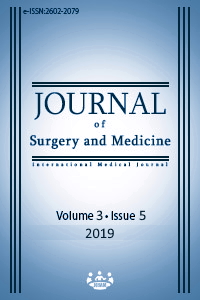Comparative study of totally extra-peritoneal hernia repair versus open Lichtenstein hernioplasty for the treatment of primary inguinal hernia
Keywords:
TEP, Lichtenstein, Recurrence rate, Pain, Postoperative complicationsAbstract
Aim: There is still controversy over which inguinal hernia repair technique has the best postoperative results. Totally extra-peritoneal hernia (TEP) repair was compared with conventional open Lichtenstein (OL) herniorrhaphy in terms of postoperative pain, return time to work, recurrence rates and complications.
Methods: In this predesigned comparative study, total number of 97 patients who underwent TEP or Lichtenstein herniorrhaphy in Health Sciences University, Kanuni Sultan Süleyman Education and Research Hospital, in between January 2018 and September 2018 were evaluated and compared. Patients were divided in two groups as TEP group (n:50) and OL group (n:47). Demographic properties (age, sex), operation time, postoperative pain, hospital stay, return to work, recurrence rates and/or complications were analyzed and compared with each other.
Results: The mean operation time was 55.7 (19.90) minutes in TEP group, while it was 39.44 (10.69) minutes in OL group (P=0.001). Postoperative pain with VAS in TEP group on the first postoperative day was 3.2 (1.12) (range: 2-6), while it was 5.6 (1.02) (range: 2-8) in the OL group (P=0.001). The average time return to their routine work ranged from 6-18 days (mean 9.2 (2.03) in TEP group while it was 7-26 days (mean 14.8 (3.1)) in OL group (P= 0.001). Postoperative complications as urinary retention, seroma, hematoma formation and paresthesia sensation were higher in OL group.
Conclusion: In our study, TEP repair was superior to OL repair in terms of postoperative pain, early return to work, chronic pain, postoperative urinary retention, seroma formation and postoperative paresthesia sensation. More studies with large case series and longer follow-up periods are still needed to judge the role of laparoscopy in repairing inguinal hernias.
Downloads
References
Köckerling F, Simons MP. Current concepts of inguinal hernia repair. Visc Med. 2018;34:145–50.
Gould J. Laparoscopic versus open inguinal hernia repair. Surg Clin North Am. 2008;88:1073–81.
Çalışkan YK, Özkarabulut C, Kaygusuz A. Evaluation of Lichtenstein and posterior wall darn techniques in inguinal hernia surgery: A prospective cohort study. J Surg Med. 2018;2(2):60-4.
Köckerling F, Stechemesser B, Hukauf M, Kuthe A, Schug-Pass C. TEP versus Lichenstein: which technique is better for the repair of primary unilateral inguinal hernias in men? Surg Endosc. 2016;30:3304–13.
Myers E, Browne KM, Kavanagh DO, Hurley M. Laparoscopic (TEP) versus Lichtenstein inguinal hernia repair: a comparison of quality-of-life outcomes. World J Surg. 2010 Dec;34(12):3059-64.
Choi YY, Kim Z, Hur KY. Swelling after laparoscopic total extra-peritoneal repair of inguinal hernias: review of one surgeon's experience in 1,065 cases. World J Surg. 2011;35:43–6.
Sevinç B, Damburacı N, Güner M, Karahan Ö.Comparison of early and long term outcomes of open Lichtenstein repair and totally extra-peritoneal herniorrhaphy for primary inguinal hernias. Turk J Med Sci. 2019;49:38-41.
Sağıroğlu J, Özdemir T, Atak T, Gök MA, Erdoğan KO, Eren T et al. Laparoscopic Total Extra-peritoneal Inguinal Hernia Repair Without Mesh Fixation: Report of Early Outcomes. South. Clin. Ist. Euras. 2016;27(3):215-9.
Tam KW, Liang HH, Chai CY. Outcomes of staple fixation of mesh versus nonfixation in laparoscopic total extra-peritoneal inguinal repair: a meta-analysis of randomized controlled trials. World J Surg. 2010 Dec;34(12):3065-74.
Koning GG, Wetterslev J, van Laarhoven CJHM, Keus F. The totally extra-peritoneal method versus Lichtenstein’s technique for inguinal hernia repair: a systematic review with meta-analyses and trial sequential analyses of randomized clinical trials. PLoS One. 2013;8(1):e52599.
Langeveld HR, van’t Riet M, Weidema WF, Stassen LPS, Steyerberg EW, Lange J, et al. Total extra-peritoneal inguinal hernia repair compared with Lichtenstein (the LEVEL-Trial): a randomized controlled trial. Ann Surg. 2010;251:819-24.
Hasbahceci M, Basak F, Acar A, Alimoglu O. A New Proposal for Learning Curve of TEP Inguinal Hernia Repair: Ability to Complete Operation Endoscopically as a First Phase of Learning Curve. Minim Invasive Surg. 2014;2014:528517.
Schouten N, Elshof JW, Simmermacher RK, van Dalen T, de Meer SG, Clevers GJ, et al. Selecting patients during the "learning curve" of endoscopic Totally Extra-peritoneal (TEP) hernia repair. Hernia. 2013;17(6):737-43.
Khury E, van Veen RN, Langeveld HR, Steyerberg EW, Jeekel J, Bonjer HJ. Open or endoscopic total extra-peritoneal inguinal hernia repair? A systematic review. Surg Endosc. 2007;21:161–6.
Bracale U, Andreuccetti J, Sodo M, Merola G, Pignata G. Lack of advantages of slit mesh placement during laparoscopic transabdominal preperitoneal inguinal hernia repair (TAPP): a single centre, case matched study BMC Surg. 2018;18 Sep 20;18(1):75.
Reiner MA, Bresnahan ER. Laparoscopic Total Extra-peritoneal Hernia Repair Outcomes. JSLS. 2016 Jul-Sep;20(3):e2016.00043.
Bansal VK, Misra MC, Babu D, Victor J, Kumar S, Sagar R, et al. A prospective, randomized comparison of long-term outcomes: chronic groin pain and quality of life following totally extra-peritoneal (TEP) and transabdominal preperitoneal (TAPP) laparoscopic inguinal hernia repair. Surg Endosc. 2013;27:2373–82.
Downloads
- 1188 1569
Published
Issue
Section
How to Cite
License
Copyright (c) 2019 Yasin Kara
This work is licensed under a Creative Commons Attribution-NonCommercial-NoDerivatives 4.0 International License.
















